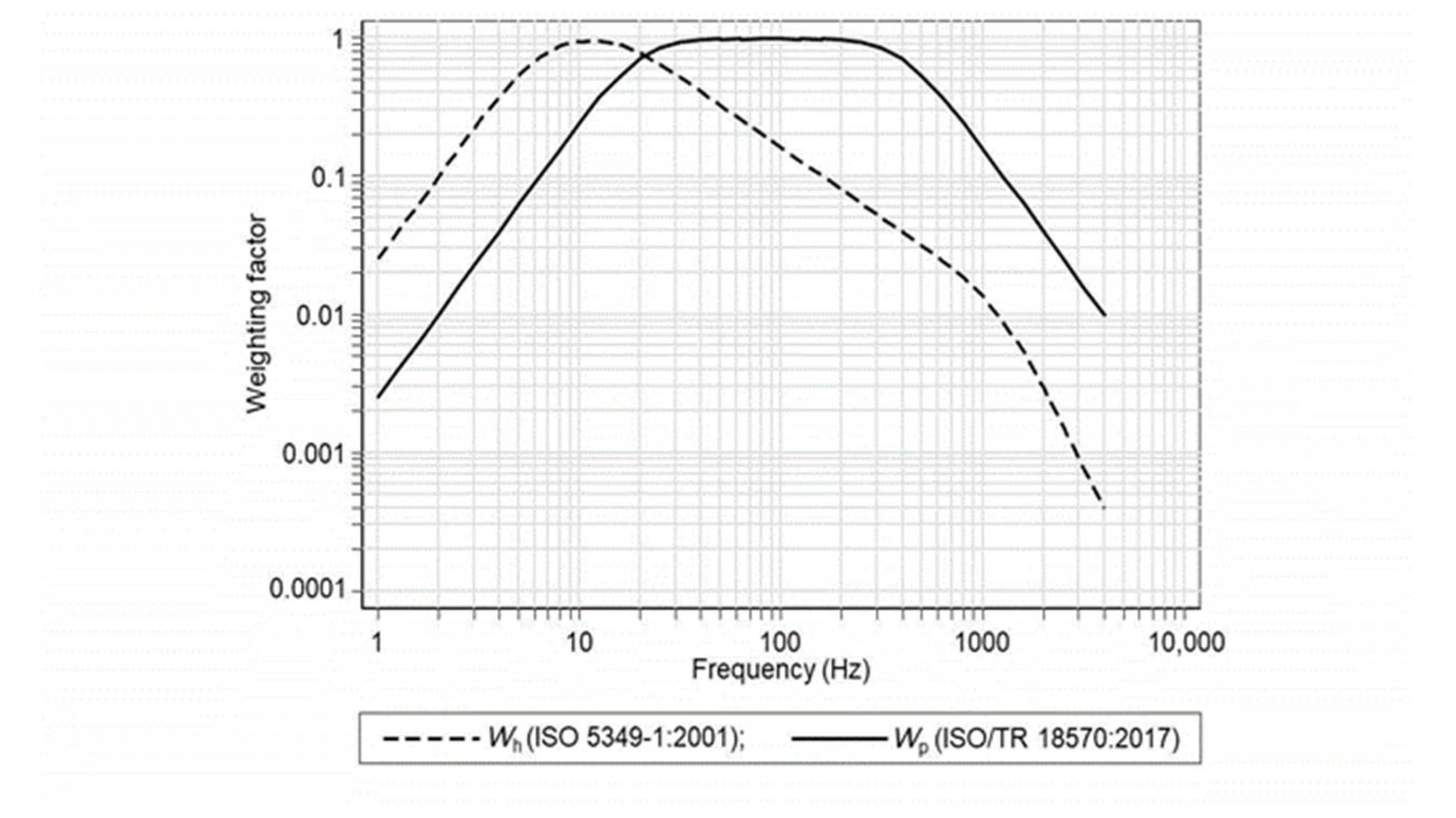Cold Response of Digital Vessels and Metrics of Daily Vibration Exposure †
Abstract
:1. Introduction
2. Material and Methods
2.1. The Cold Test
2.2. Vibration Exposure
2.3. Data Analysis
3. Results
4. Discussion
Author Contributions
Funding
Institutional Review Board Statement
Informed Consent Statement
Data Availability Statement
Conflicts of Interest
References
- Krajnak, K.; Riley, D.A.; Wu, J.; McDowell, T.; Welcome, D.E.; Xu, X.S.; Dong, R.G. Frequency-dependent effects of vibration on physiological systems: Experiments with animals and other human surrogates. Ind. Health 2012, 50, 343–353. [Google Scholar] [CrossRef] [PubMed] [Green Version]
- Bovenzi, M. Epidemiological evidence for new frequency weightings for hand-transmitted vibration. Ind. Health 2012, 50, 377–387. [Google Scholar] [CrossRef] [PubMed] [Green Version]
- SO 5349-1; Mechanical Vibration—Measurement and Evaluation of Human Exposure to Hand Transmitted Vibration—Part 1: General Requirements. ISO: Geneva, Switzerland, 2001.
- Bovenzi, M.; Pinto, I.; Picciolo, F. Risk assessment of vascular disorders by a supplementary hand-arm vascular weighting of hand-transmitted vibration. Int. Arch. Occup. Environ. Health 2019, 92, 129–139. [Google Scholar] [CrossRef] [PubMed]
- ISO/TR 18570; Mechanical Vibration—Measurement and Evaluation of Human Exposure to Hand Transmitted Vibration—Supplementary Method for Assessing Risk of Vascular Disorders. ISO: Geneva, Switzerland, 2017.
- Raftery, A.E. Bayesian model selection in social research. Sociol. Methodol. 1995, 25, 111–163. [Google Scholar] [CrossRef]
- Bovenzi, M.; Lindsell, C.J.; Griffin, M.J. Acute vascular responses to the frequency of vibration transmitted to the hand. Occup. Environ. Med. 2000, 57, 422–430. [Google Scholar] [CrossRef] [PubMed] [Green Version]

| Factors | Controls (n = 138) | HTV Workers (n = 249) | |
|---|---|---|---|
| Non-VWF (n = 195) | VWF (n = 54) | ||
| Age (yr) | 38.8 (34.1–45.9) | 42.1 (33.6–46.8) | 43.0 (34.8–52.2) |
| BMI (kg/m2) | 24.5 (23.0–27.2) | 25.7 (23.2–27.4) | 24.5 (23.2–26.8) |
| Current smokers (n) | 29 (21.0) | 85 (43.6) | 28 (51.8) * |
| Drinkers (n) | 104 (75.4) | 145 (74.4) | 47 (87.0) |
| Ah(8) (ms−2 r.m.s.) | - | 3.59 (2.48–5.21) | 4.54 (3.44–7.94) ** |
| Ap(8) (ms−2 r.m.s.) | - | 17.9 (12.5–27.4) | 26.5 (16.1–78.9) ** |
| Duration of exposure (y) | - | 15 (7–21) | 17 (11–23) |
| FSBPt,30° (mmHg) | 120 (110–135) | 130 (115–140) | 125 (110–140) |
| FSBPref,30° (mmHg) | 130 (118–140) | 130 (120–140) | 130 (115–140) |
| %FSBP10° (%) | 92.9 (85.7–100) | 91.7 (81.8–100) | 81.7 (60.0–94.7) *** |
| Factors | Model 1 a | Model 2 b | ||
|---|---|---|---|---|
| Ah(8) (×1 ms−2) | Ap(8) (×10 ms−2) | Ah(8) (×1 ms−2) | Ap(8) (×10 ms−2) | |
| Af(8) (ms−2 r.m.s.) | −1.23 (−1.63; −0.84) | −1.30 (−1.68; −0.92) | −0.98 (−1.38; −0.58) | −1.12 (−1.52; −0.71) |
| Duration of exposure (y) | - | - | −0.07 (−0.25; 0.12) | −0.03 (−0.22; 0.15) |
| VWF | - | - | −7.59 (−11.1; −4.03) | −7.02 (−10.6; −3.44) |
| LR test c2 (Af(8)) c | 34.7 | 41.1 | 20.4 | 26.8 |
| Model fitting (BIC) | 7746 | 7739 | 7780 | 7773 |
| ΔBIC | 7 | 7 | ||
Disclaimer/Publisher’s Note: The statements, opinions and data contained in all publications are solely those of the individual author(s) and contributor(s) and not of MDPI and/or the editor(s). MDPI and/or the editor(s) disclaim responsibility for any injury to people or property resulting from any ideas, methods, instructions or products referred to in the content. |
© 2023 by the authors. Licensee MDPI, Basel, Switzerland. This article is an open access article distributed under the terms and conditions of the Creative Commons Attribution (CC BY) license (https://creativecommons.org/licenses/by/4.0/).
Share and Cite
Bovenzi, M.; Tarabini, M. Cold Response of Digital Vessels and Metrics of Daily Vibration Exposure. Proceedings 2023, 86, 6. https://doi.org/10.3390/proceedings2023086006
Bovenzi M, Tarabini M. Cold Response of Digital Vessels and Metrics of Daily Vibration Exposure. Proceedings. 2023; 86(1):6. https://doi.org/10.3390/proceedings2023086006
Chicago/Turabian StyleBovenzi, Massimo, and Marco Tarabini. 2023. "Cold Response of Digital Vessels and Metrics of Daily Vibration Exposure" Proceedings 86, no. 1: 6. https://doi.org/10.3390/proceedings2023086006
APA StyleBovenzi, M., & Tarabini, M. (2023). Cold Response of Digital Vessels and Metrics of Daily Vibration Exposure. Proceedings, 86(1), 6. https://doi.org/10.3390/proceedings2023086006







